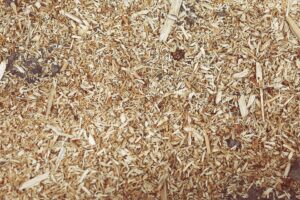Do you really know your mulches from your composts?
By Michael Casey
We use mulch and compost products all the time, from applying them to our finished landscapes and gardens, through to large scale urban farms and agricultural settings. However, do we really know what it is we are mixing into, or adding to our soils? And if this is the case, do we know the difference between and a mulch and a compost, and more importantly the benefits and considerations for both options?
For thirty years, I have had clients refer to mulch and compost as one and the same thing. I have also heard references amongst garden professionals to ‘mulch the garden’, to then follow up with begging the question of what type of mulch to use or, ‘why apply mulch when we just applied compost’? With the right knowledge, we can determine whether mulch, compost or a combination is going to best suit the needs of that next project.
Mulch is defined by the Collins Dictionary as “a layer of something such as old leaves, small pieces of wood, or manure which you put on the soil round plants in order to protect them and help them to grow”. Mulch comes in many forms, both natural and manufactured, and all serve a similar purpose which is to suppress weed growth, retain moisture levels in the soil, keep the soil cool/warm dependent on the seasons, provide nutrients, prevent frosting and lastly, for aesthetic purposes. Mulches extend beyond ‘soil deep’ – they can achieve much more when chosen correctly. This includes improving the soil structure, drainage, nutrient load, and water holding capacity as the materials break down.
Inorganic mulches such as plastics, rubber and fibre-based products, obviously all work a bit differently and will suppress weed growth but can also build up the temperature in the soils that can damage microorganisms and beneficial insects living in your soil, affect water entering your soil structure, and will also limit oxygen entering your soils. Inorganic mulches such as the ones mentioned above, also break down over time, potentially releasing chemicals into the soil. Organic mulches can be, and are often applied over the top of inorganic mulches such as plastic and weed mats. Personally, I’m not in favour of this method as it does affect the water entering the soil structure, and will affect the amount of nutrients entering the soil from manual application through to the natural breakdown of the mulch itself. With this, what are the other approaches to be explored?

Common organic mulches can be purchased as wood mulch (chips, barks, etc.), grass clippings, straw (pea straw, lucerne) and in some cases, mulch can be applied in the form of pebbles and gravel, however all these options do come with their advantages and disadvantages, therefore knowing your product and plants will assist in determining what to use. For example, roof gardens will commonly apply a gravel mulch to protect the lightweight artificial media blowing away in windy conditions. If mulch is being sought for decorative purposes, a coloured or textured mulch will be suitable, however this could cause issues with nutrient deficiencies and may not assist with water penetration. If a mulch is intended to assist with soil conditioning, nutrient loading and more efficient water holding in the soil, aged barks and composts with varying particle sizes may be most suitable. The use of mulch after cultivating in an aged compost may be a better alternative to use when soils are impoverished and require initial nutrient loading. By understanding the existing soil conditions and the planting palette, this will assist in determining the right mulch and mixture to use.
Mulch in most cases, and there are some exceptions, should be applied to the surface of the soil and not used in tillage and cultivating of soils. Mulch should be applied to a depth of 40-80mm, depending on the particle size of the product and the product being used. And if in doubt, always remember to ask the suppliers who are offering these products.
Composts are organic materials that have decomposed and been tumbled and turned for a minimum of six weeks. They are categorised into their degree of fineness, degree of composting and level of phosphorus. Compost commonly comes in the form of aged council and construction waste that includes a mixture of materials such as timbers, demolition waste and garden waste. When correctly composted, the heating process will destroy most weed seeds leaving a rich nutrient soil additive. It will not, on the other hand, break down the many foreign objects and nasty products that can contaminate the green waste prior to the composting process.
Many of us would have many stories of finding foreign objects, both plastic and steel, littering our compost when delivered to site. There was a case reported in the media recently in Victoria, where several garden supply companies received a product that had been contaminated with herbicide that was still present in the green waste supplied to the original composting contractor. The companies behind the recycling of green waste work hard at ensuring their products are safe, however awareness, education and updated standards needs to be reviewed amongst recyclers to ensure they are informed as to which materials are safe, to both receive and then send off to consumers.
Composts that range in particle size are added to soil and cultivated into the structure. It can also be added as a mulch layer as this product will enrich the soil, help retain moisture and suppress plant diseases and pests. This usage reduces the need for chemical fertilisers and encourages the production of beneficial bacteria and fungi that break down organic matter to create humus, a rich nutrient-filled material. And most importantly, it reduces methane emissions from landfills and lowers your carbon footprint.
Whether it be adding rich and well composted material or the right mulch to your next project, it will ultimately come down to the relevant specifications, the project objectives and your product knowledge that will ensure you can safely specify the right product,and ensure a healthy and beautiful looking garden.
There is an Australian Standard that governs the quality of mulch and compost products (AS 4454 Composts, soil conditioners and mulches) and this stipulates the three different categories that mulches and composts are catergorised under. Particle size differentiation determines the sizes of the mulches and composts into coarse and fine. If there are too many fines in a mulch for example, the product will ‘crust’ on the surface making water penetration difficult. The degree of decomposition which the mulch and compost has been subject to, and also the phosphorus levels in the mulch need to be evaluated when using around Australian native plants. And if you are unsure about what options to use, ask your local garden suppliers, soil yard or nursery for assistance and knowledge on the products they stock.
Michael Casey MAIH RH 106
Director, Evergreen Infrastructure and MJC Horticulture
National President of Australian Institute of Horticulture
Board Member Interior Plantscape Australia
E:president@aih.org.au E: Michael@evergreeninfrastructure.com.au

